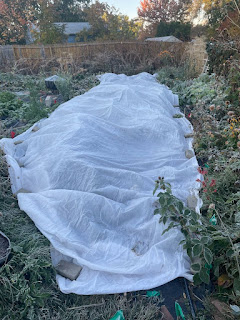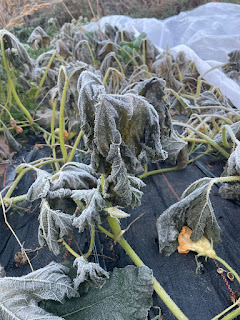"It is always important to know when something has reached its end. Closing circles, shutting doors, finishing chapters, it doesn’t matter what we call it; what matters is to leave in the past those moments in life that are over." - Paulo Coelho
Alas, all good things must come to an end. If we're being real, all things come to an end at some point regardless of if they're good or not, that's just the way the cookie crumbles. As far as your garden is concerned a good freeze will surely bring it's productivity to a sudden end. Depending on where you're at you may have already experienced a freeze, it may be just around the corner or you may be in a location that doesn't have freezes. In the front range of good old Colorado, we're just in the midst of a freeze with the temperatures flirting with freezing. Even if the temperatures are forecast to get down to 31 or 30 degrees Fahrenheit, it's a fun game of will the ground be warm enough from the daytime sun to keep the plants slightly warmer than the actual temperature. I've certainly been surprised before and I'll surely be surprised again.
Throughout the year you should be constantly looking at the weather each and every day, yes each day. In the fall, when you see the low temperatures in the forecast going below 40 degrees alarm bells should be going off in your head. Oh crap, a freeze is coming, I need to harvest everything, drain the irrigation, put the dahlias away, break out the row covers. You suddenly go from having nothing to do to needing to do everything all at once (again).
Once you see those low temperatures in the forecast, start harvesting, be sure your freezer and fridge is full. Wait to fill your fridge until the very last moment since everything in the fridge has a fairly short lifespan before it goes bad and you want to give yourself the longest possible time to eat everything, you can only eat so much after all. If you grow dahlias (which you should if you don't, they're gorgeous) be sure to put them away, the tubers go into burlap sacks and store them inside in a dry, cool place for the winter.
When you see lows getting down to 34 degrees, break out the row covers (if using) as a freeze is imminent. Cover your fall crops to try and keep them alive as long as possible so you have fresh food for as long as possible. Managing row covers are a bit of an art form in themselves, if it is still getting hot during the day you may want to peel the covers back so the plants don't get too hot, then put them back over at night. That's a lot of work though, when in doubt just let leave them covered.
 |
| Row covers deployed to try and keep the fall crops alive, October of 2021 |
Also when the lows are forecasted to get down to 34 degrees, drain your irrigation system IMMEDIATELY. Don't play around with this, when the temperatures are flirting with freezing, get that water out of the pipes, ASAP. Water expands when it freezes so if water is in your irrigation system when this happens suddenly all of your irrigation lines are broken and you have to completely rebuild your irrigation system. Don't play around with this, just drain the irrigation system. It's much easier (and cheaper) to have to drain it a few times a week for a few weeks as opposed to completely replacing your irrigation system.
Once you have the row covers out and the irrigation system has drained, it's time to do one final pass over your veggies and see if there's anything else that can be harvested that you missed previously. Keep in mind that your cold weather plants may be okay in 32 degree weather (or slightly below) or it might kill them but your warm weather plants (tomatoes, peppers, okra, etc.) will most certainly die in temps 32 and below. Focus your harvesting efforts on the warm weather plants first then the cold weather plants. Your winter squash (pumpkins, blue hubbards, etc), generally develop a pretty thick skin and will probably be okay for a few nights in slightly freezing weather (the actual fruit anyways, the vines will still die). Be sure to pull them inside when you can though.
Once the freeze has come and decimated your plants, for the love of god, do not throw out your plants, cut them at the base with your snips and put the dead plant on the ground either in-between the rows or in the actual rows themselves. This way the plant itself decomposes back into the soil to improve your soil health and your leaving the roots in the ground to do the same thing. If you throw the plants in the garbage, you're literally throwing away soil gold, don't do that, let them follow the natural process of decomposition so your soil is healthier and stronger next year!
There you have it, freezing temps take you from having nothing to do to having to do everything all at once and now you know the very important things that you must do once you see freezing temperatures in the forecast and what you should do with your plants after the freeze. It's a fun time of year and be sure to stop and smell the roses and enjoy it from time to time. It's way too easy to get caught up in the hustle and bustle of everything that needs to be done and you completely forget to enjoy all your hard work, which is very important. Enjoy it while you can!!! After all, everything comes to an end.

No comments:
Post a Comment